Application of Time-Resolved Multi-Sine Impedance Spectroscopy for Lithium-Ion Battery Characterization
Abstract
:1. Introduction
2. Usage of Multi-Sine Signals for Electrochemical Impedance Spectroscopy
3. Prerequisites for Validity of Impedance Spectra
4. Design of Multi-Sine Excitation Signals
4.1. Frequency Distribution and Spacing
4.2. Time-Domain Behavior: Amplitude Response Limitation and Crest Factor Optimization
- Step 1: Synthesize signal in frequency domain with initial phase values.
- Step 2: Transfer into time domain by inverse FFT.
- Step 3: Clip signal peaks according to a specified criterion.
- Step 4: Transfer into frequency domain by FFT.
- Step 5: Save phase new values for desired frequency components.
- Step 6: Repeat with new phase values.
5. Signal Processing—Frequency Domain Transformation and Windowing
6. Experimental Comparison of Stepped-Sine and Multi-Sine Excitation
6.1. Measurement Setup
6.2. EIS Measurements of Precision Shunt Resistor
6.3. EIS Measurements of Reference Impedance Device
7. Application of Time-Resolved EIS for Lithium-Ion Battery Characterization
8. Conclusions and Outlook
Author Contributions
Funding
Acknowledgments
Conflicts of Interest
Abbreviations
| BMS | Battery Management System |
| DFT | Discrete Fourier Transform |
| EIS | Electrochemical Impedance Spectroscopy |
| FFT | Fast Fourier Transform |
| LTI | Linear Time-invariant |
Appendix A
| Signal | Stepped-Sine | Multi-Sine High Power | Multi-Sine Low Power |
|---|---|---|---|
| 1 Hz | 1 Hz | 1 Hz | |
| 1 kHz | 1 kHz | 1 kHz | |
| Frequency Distribution | quasi-log. | quasi-log. | quasi-log. |
| Frequency Points | 20 | 20 | 20 |
| Periods per Point | 10 | variable | variable |
| RMS Current | mA | mA | mA |
| Amplitude per Frequency Point | mA | mA | mA |
| Peak Current Amplitude | mA | mA | mA |
| Crest Factor | 1.41 | 2.53 | 2.53 |
| Signal Power | W | 561 W | W |
| Signal Length | s | 1 s | 1 s |
| Signal Energy | mJ | mJ | mJ |
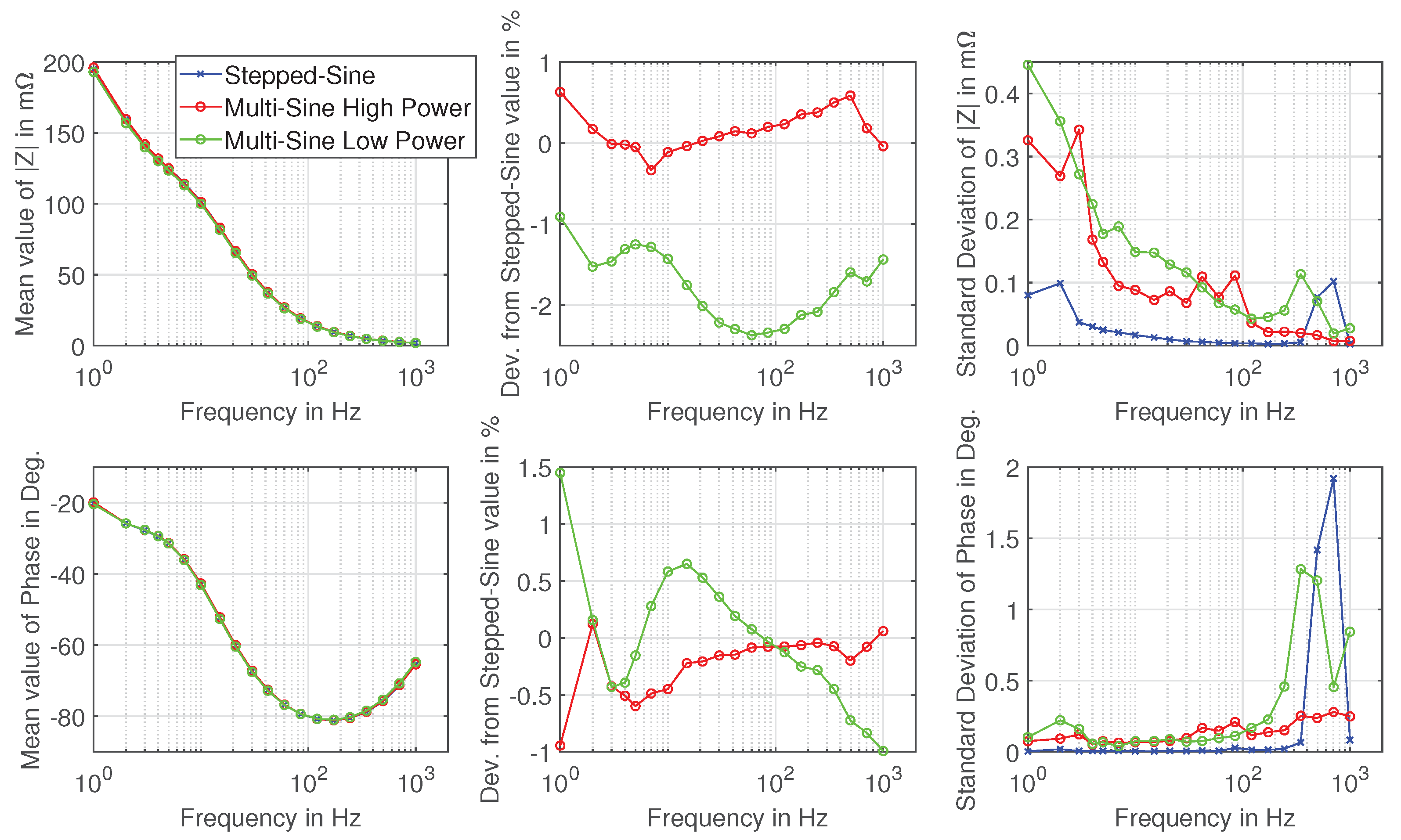
References
- Kurzweil, P.; Shamonin, M. State-of-Charge Monitoring by Impedance Spectroscopy during Long-Term Self-Discharge of Supercapacitors and Lithium-Ion Batteries. Batteries 2018, 4, 35. [Google Scholar] [CrossRef]
- Vyroubal, P.; Kazda, T. Equivalent circuit model parameters extraction for lithium ion batteries using electrochemical impedance spectroscopy. J. Energy Storage 2018, 15, 23–31. [Google Scholar] [CrossRef]
- Howey, D.A.; Mitcheson, P.D.; Yufit, V.; Offer, G.J.; Brandon, N.P. Online Measurement of Battery Impedance Using Motor Controller Excitation. IEEE Trans. Veh. Technol. 2014, 63, 2557–2566. [Google Scholar] [CrossRef]
- Ringbeck, F.; Nordmann, H.; Sauer, D.U. Design eines preiswerten Impedanzspektroskopiesystems für den Einsatz in Batteriepacks. In Tagungsband zum Power and Energy Student Summit 2014 in Stuttgart; Tenbohlen, S., Ellerbrock, A., Eds.; Univ.: Stuttgart, Germany, 2014. [Google Scholar]
- Din, E.; Schaef, C.; Moffat, K.; Stauth, J.T. Online spectroscopic diagnostics implemented in an efficient battery management system. In Proceedings of the 2015 IEEE 16th Workshop on Control and Modeling for Power Electronics (COMPEL), Vancouver, BC, Canada, 12–15 July 2015; IEEE: Piscataway, NJ, USA, 2015; pp. 1–7. [Google Scholar] [CrossRef]
- Srinivasan, R.; Carkhuff, B.G.; Butler, M.H.; Baisden, A.C. Instantaneous measurement of the internal temperature in lithium-ion rechargeable cells. Electrochim. Acta 2011, 56, 6198–6204. [Google Scholar] [CrossRef]
- Richardson, R.R.; Ireland, P.T.; Howey, D.A. Battery internal temperature estimation by combined impedance and surface temperature measurement. J. Power Sources 2014, 265, 254–261. [Google Scholar] [CrossRef]
- Barsoukov, E.; Macdonald, J.R. (Eds.) Impedance Spectroscopy: Theory, Experiment, and Applications, 2nd ed.; Wiley-Interscience a John Wiley & Sons Inc. Publication: Hoboken, NJ, USA, 2005. [Google Scholar] [CrossRef]
- Kiel, M. Impedanzspektroskopie an Batterien unter Besonderer Berücksichtigung von Batteriesensoren für den Feldeinsatz; Aachener Beiträge des ISEA; Shaker: Aachen, Germany, 2013; Volume 67. [Google Scholar]
- Ojarand, J.; Min, M.; Annus, P. Crest factor optimization of the multisine waveform for bioimpedance spectroscopy. Physiol. Meas. 2014, 35, 1019–1033. [Google Scholar] [CrossRef] [PubMed]
- Sanchez, B.; Vandersteen, G.; Bragos, R.; Schoukens, J. Optimal multisine excitation design for broadband electrical impedance spectroscopy. Meas. Sci. Technol. 2011, 22, 115601. [Google Scholar] [CrossRef]
- Breugelmans, T.; Tourwé, E.; van Ingelgem, Y.; Wielant, J.; Hauffman, T.; Hausbrand, R.; Pintelon, R.; Hubin, A. Odd random phase multisine EIS as a detection method for the onset of corrosion of coated steel. Electrochem. Commun. 2010, 12, 2–5. [Google Scholar] [CrossRef]
- Tröltzsch, U.; Kanoun, O.; Tränkler, H.R. Characterizing aging effects of lithium ion batteries by impedance spectroscopy. Electrochim. Acta 2006, 51, 1664–1672. [Google Scholar] [CrossRef]
- Schmidt, J.P. Verfahren zur Charakterisierung und Modellierung von Lithium-Ionen Zellen; Schriften des Instituts für Werkstoffe der Elektrotechnik, Karlsruher Institut für Technologie; KIT Scientific Publishing: Karlsruhe, Germany, 2013; Volume 25. [Google Scholar]
- Urquidi-Macdonald, M.; Real, S.; Macdonald, D.D. Applications of Kramers—Kronig transforms in the analysis of electrochemical impedance data—III. Stability and linearity. Electrochim. Acta 1990, 35, 1559–1566. [Google Scholar] [CrossRef]
- Kowal, J. Spatially-Resolved Impedance on Nonlinear Inhomogenerous Devices: Using the Example of Lead-Acid Batteries; Aachener Beiträge des ISEA; Shaker: Aachen, Germany, 2010; Volume 53. [Google Scholar]
- Schiller, C.A.; Richter, F.; Gülzow, E.; Wagner, N. Validation and evaluation of electrochemical impedance spectra of systems with states that change with time. Phys. Chem. Chem. Phys. 2001, 3, 374–378. [Google Scholar] [CrossRef]
- Illig, J. Physically Based Impedance Modelling of Lithium-Ion Cells; Schriften des Instituts für Werkstoffe der Elektrotechnik, Karlsruher Institut für Technologie; KIT Scientific Publishing: Karlsruhe, Baden, 2014; Volume 27. [Google Scholar]
- Waag, W.; Käbitz, S.; Sauer, D.U. Experimental investigation of the lithium-ion battery impedance characteristic at various conditions and aging states and its influence on the application. Appl. Energy 2013, 102, 885–897. [Google Scholar] [CrossRef]
- Schindler, S.; Danzer, M.A. Influence of cell design on impedance characteristics of cylindrical lithium-ion cells: A model-based assessment from electrode to cell level. J. Energy Storage 2017, 12, 157–166. [Google Scholar] [CrossRef]
- Gaberscek, M.; Moskon, J.; Erjavec, B.; Dominko, R.; Jamnik, J. The Importance of Interphase Contacts in Li Ion Electrodes: The Meaning of the High-Frequency Impedance Arc. Electrochem. Solid-State Lett. 2008, 11, A170. [Google Scholar] [CrossRef]
- Momma, T.; Matsunaga, M.; Mukoyama, D.; Osaka, T. Ac impedance analysis of lithium ion battery under temperature control. J. Power Sources 2012, 216, 304–307. [Google Scholar] [CrossRef]
- Schmitz, M.J.; Green, R.A. Optimization of multisine excitations for receiver undersampling. In Proceedings of the IEEE International Conference on Acoustics, Speech and Signal Processing (ICASSP), Dallas, TX, USA, 15–19 March 2010; Douglas, S.C., Ed.; IEEE: Piscataway, NJ, USA, 2010; pp. 1514–1517. [Google Scholar] [CrossRef]
- Hoshi, Y.; Yakabe, N.; Isobe, K.; Saito, T.; Shitanda, I.; Itagaki, M. Wavelet transformation to determine impedance spectra of lithium-ion rechargeable battery. J. Power Sources 2016, 315, 351–358. [Google Scholar] [CrossRef]
- Schroeder, M. Synthesis of low-peak-factor signals and binary sequences with low autocorrelation (Corresp.). IEEE Trans. Inf. Theory 1970, 16, 85–89. [Google Scholar] [CrossRef]
- Ojarand, J.; Min, M. Recent Advances in Crest Factor Minimization of Multisine. Elektronika ir Elektrotechnika 2017, 23. [Google Scholar] [CrossRef]
- Schoukens, J.; Pintelon, R.; van der Ouderaa, E.; Renneboog, J. Survey of excitation signals for FFT based signal analyzers. IEEE Trans. Instrum. Meas. 1988, 37, 342–352. [Google Scholar] [CrossRef]
- Horner, A.; Beauchamp, J. A genetic algorithm–based method for synthesis of low peak amplitude signals. J. Acoust. Soc. Am. 1996, 99, 433–443. [Google Scholar] [CrossRef]
- Yang, Y.; Zhang, F.; Tao, K.; Sanchez, B.; Wen, H.; Teng, Z. An improved crest factor minimization algorithm to synthesize multisines with arbitrary spectrum. Physiol. Meas. 2015, 36, 895–910. [Google Scholar] [CrossRef] [PubMed]
- Guillaume, P.; Schoukens, J.; Pintelon, R.; Kollar, I. Crest-factor minimization using nonlinear Chebyshev approximation methods. IEEE Trans. Instrum. Meas. 1991, 40, 982–989. [Google Scholar] [CrossRef]
- Kolda, T.G.; Lewis, R.M.; Torczon, V. A Generating Set Direct Search Augmented Lagrangian Algorithm for Optimization with a Combination of General and Linear Constraints; Technical Report; Sandia National Laboratories: Albuquerque, NM, USA; Livermore, CA, USA, 2006. [Google Scholar] [CrossRef]
- van der Ouderaa, E.; Schoukens, J.; Renneboog, J. Peak factor minimization of input and output signals of linear systems. IEEE Trans. Instrum. Meas. 1988, 37, 207–212. [Google Scholar] [CrossRef]
- Baumhöfer, T. Statistische Betrachtung Experimenteller Alterungsuntersuchungen an Lithium-Ionen Batterien; Aachener Beiträge des ISEA; Shaker: Aachen, Germany, 2015; Volume 74. [Google Scholar]
- Nordmann, H.; Sauer, D.U.; Kiel, M. A Nonlinear Impedance Standard. In Lecture Notes on Impedance Spectroscopy; Kanoun, O., Ed.; CRC Press/Balkema: Boca Raton, FL, USA, 2014. [Google Scholar]
- Karlsruhe Institute of Technology. Lin-KK Software Tool. Available online: https://www.iam.kit.edu/wet/english/Lin-KK.php (accessed on 1 February 2018).
- Boukamp, B.A. A Linear Kronig-Kramers Transform Test for Immittance Data Validation. J. Electrochem. Soc. 1995, 142, 1885. [Google Scholar] [CrossRef] [Green Version]
- Schönleber, M.; Ivers-Tiffée, E. Approximability of impedance spectra by RC elements and implications for impedance analysis. Electrochem. Commun. 2015, 58, 15–19. [Google Scholar] [CrossRef]
- Schönleber, M.; Klotz, D.; Ivers-Tiffée, E. A Method for Improving the Robustness of linear Kramers-Kronig Validity Tests. Electrochim. Acta 2014, 131, 20–27. [Google Scholar] [CrossRef]
- Lewerenz, M.; Marongiu, A.; Warnecke, A.; Sauer, D.U. Differential voltage analysis as a tool for analyzing inhomogeneous aging: A case study for LiFePO 4 |Graphite cylindrical cells. J. Power Sources 2017, 368, 57–67. [Google Scholar] [CrossRef]
- Takami, N. Structural and Kinetic Characterization of Lithium Intercalation into Carbon Anodes for Secondary Lithium Batteries. J. Electrochem. Soc. 1995, 142, 371. [Google Scholar] [CrossRef]
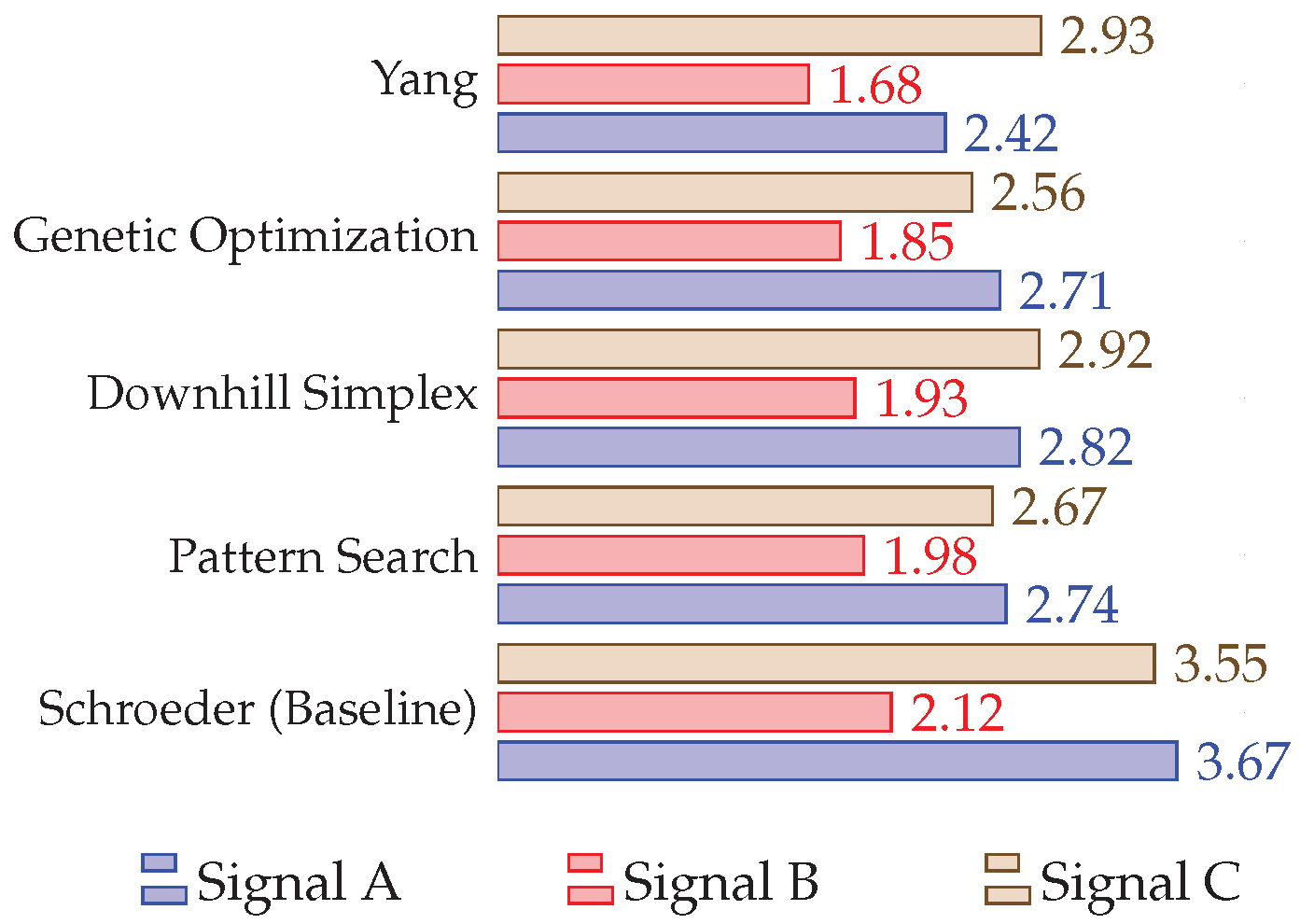
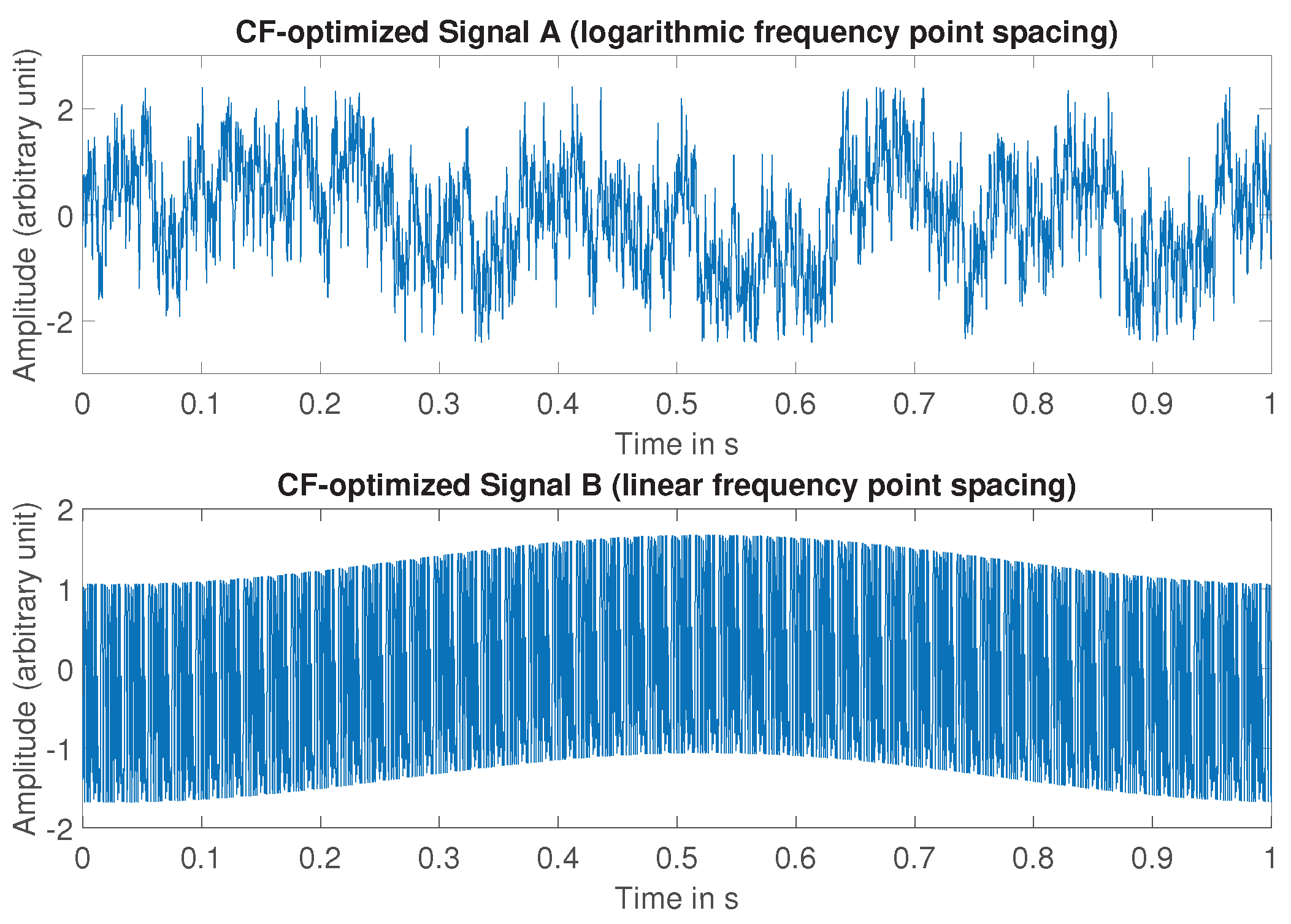

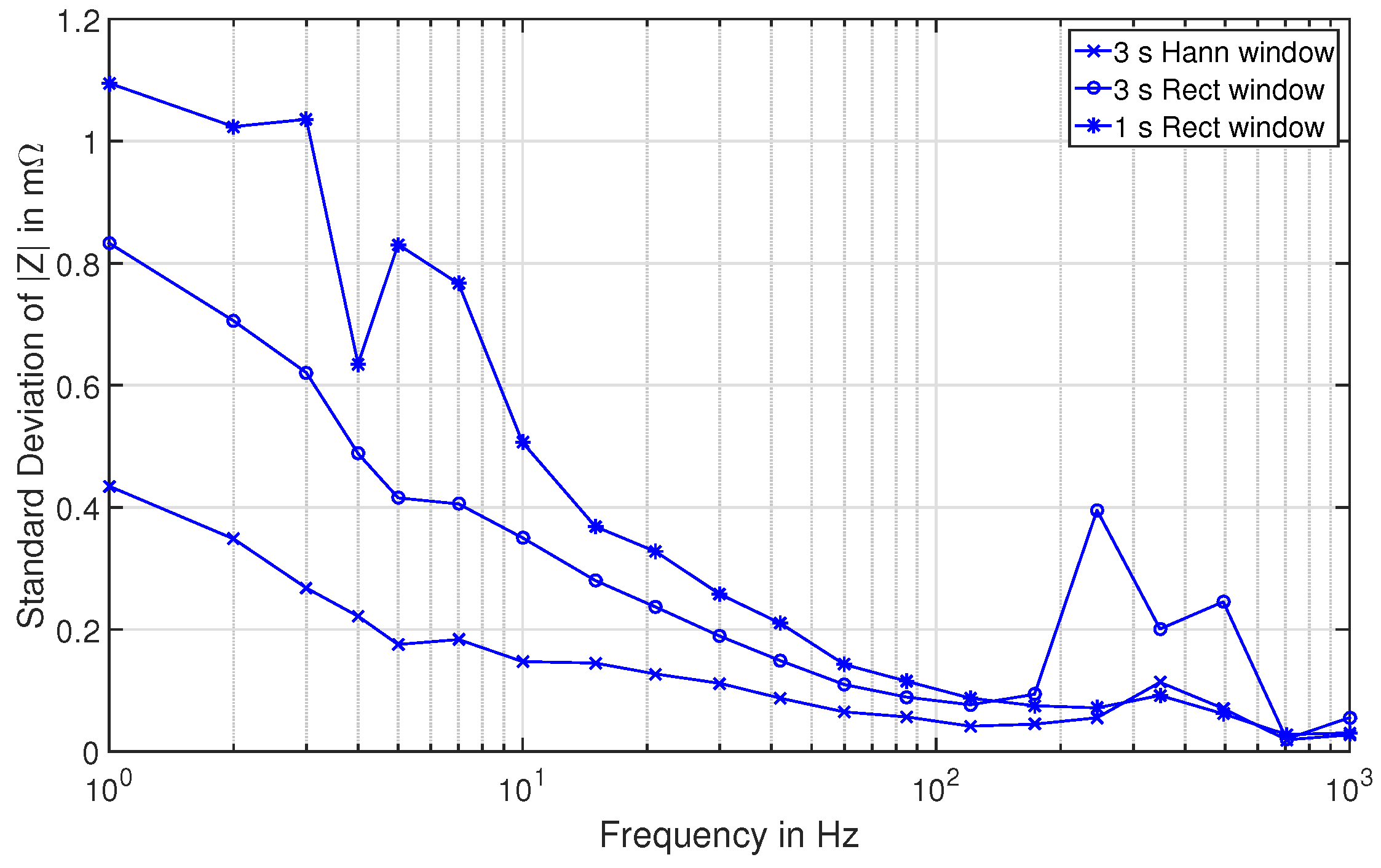
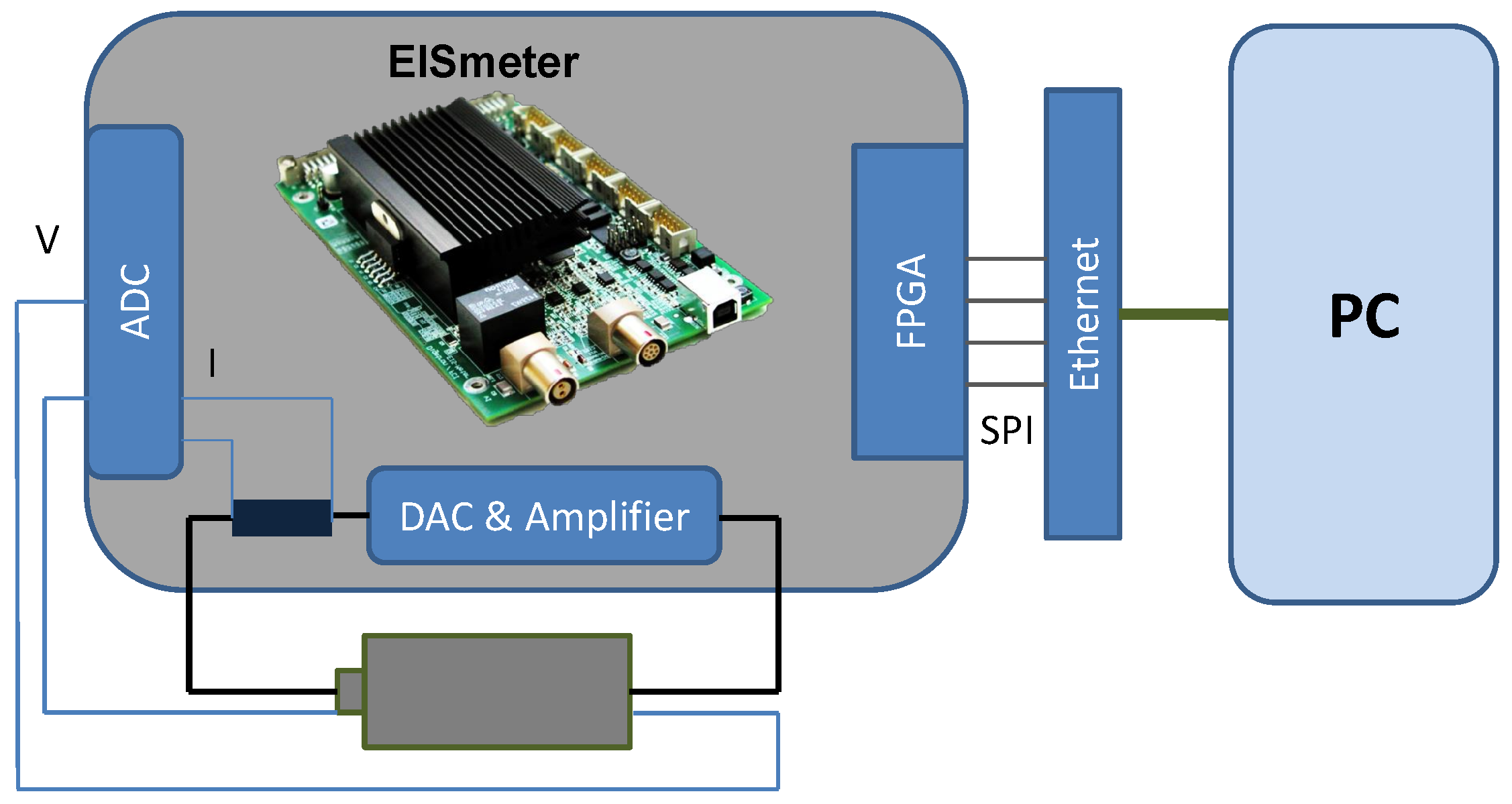
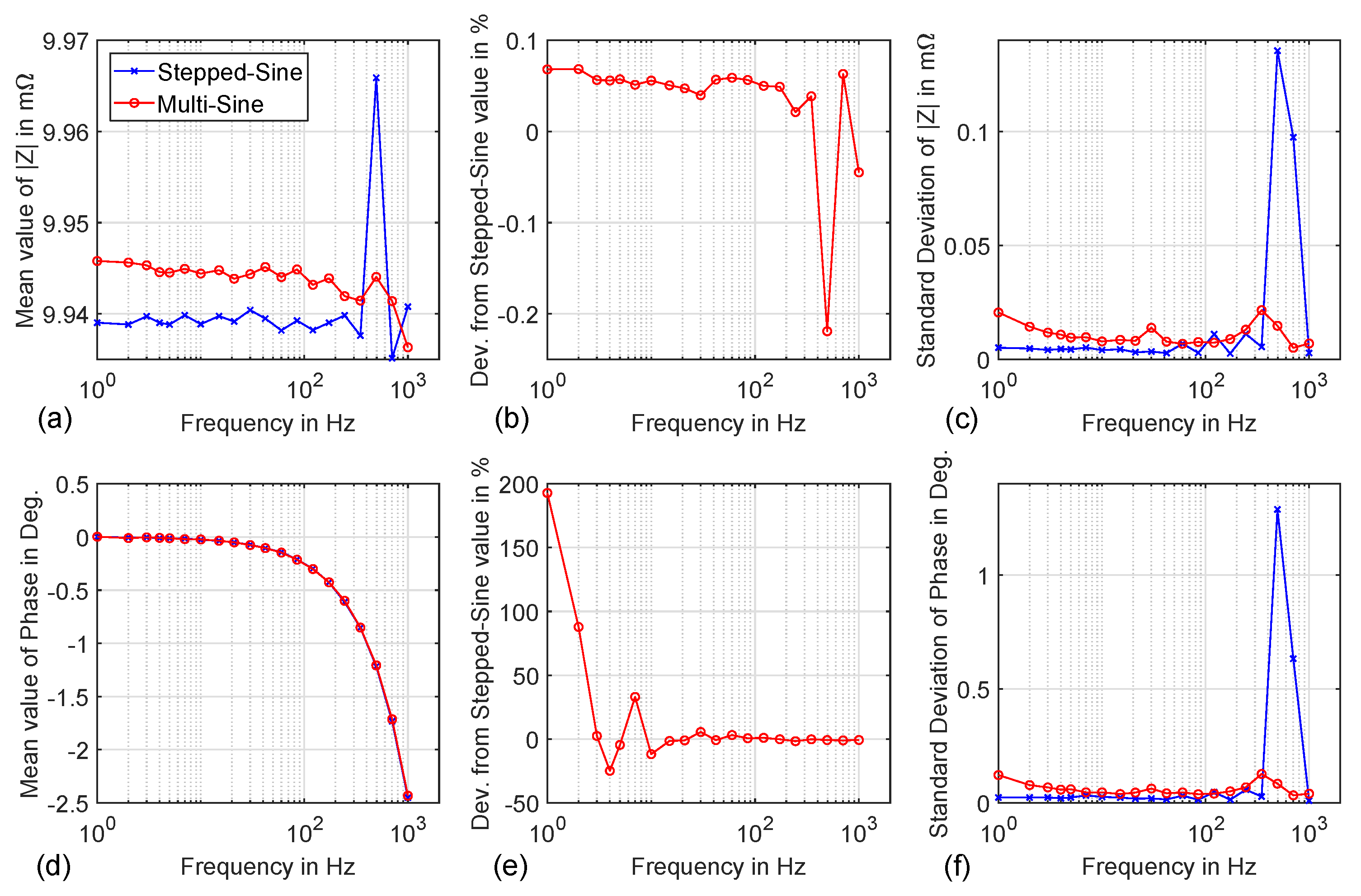
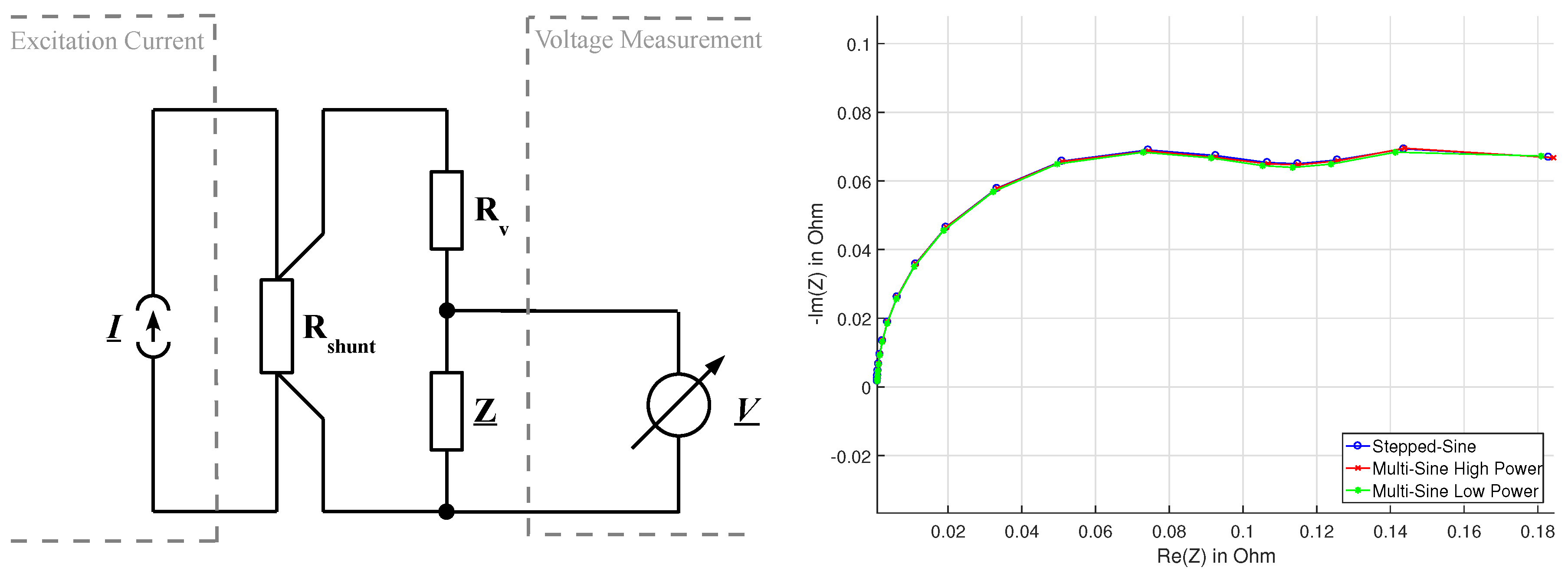
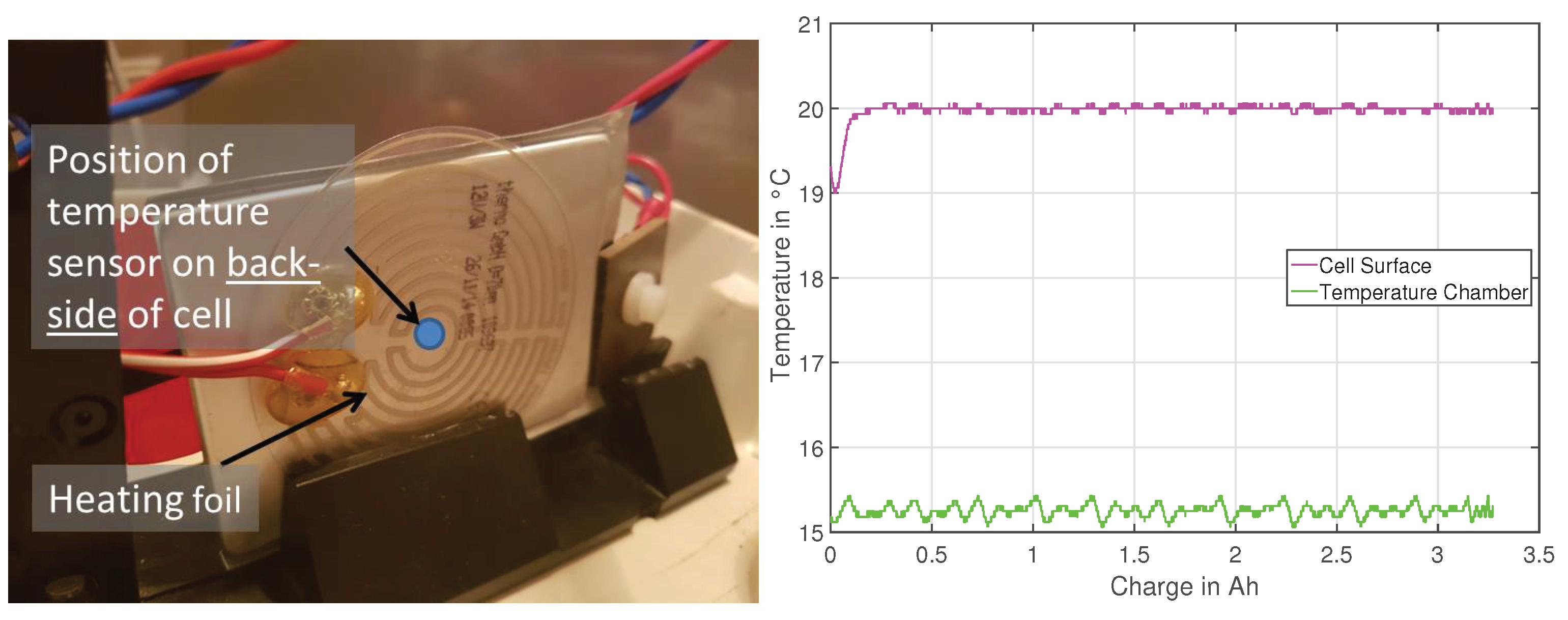
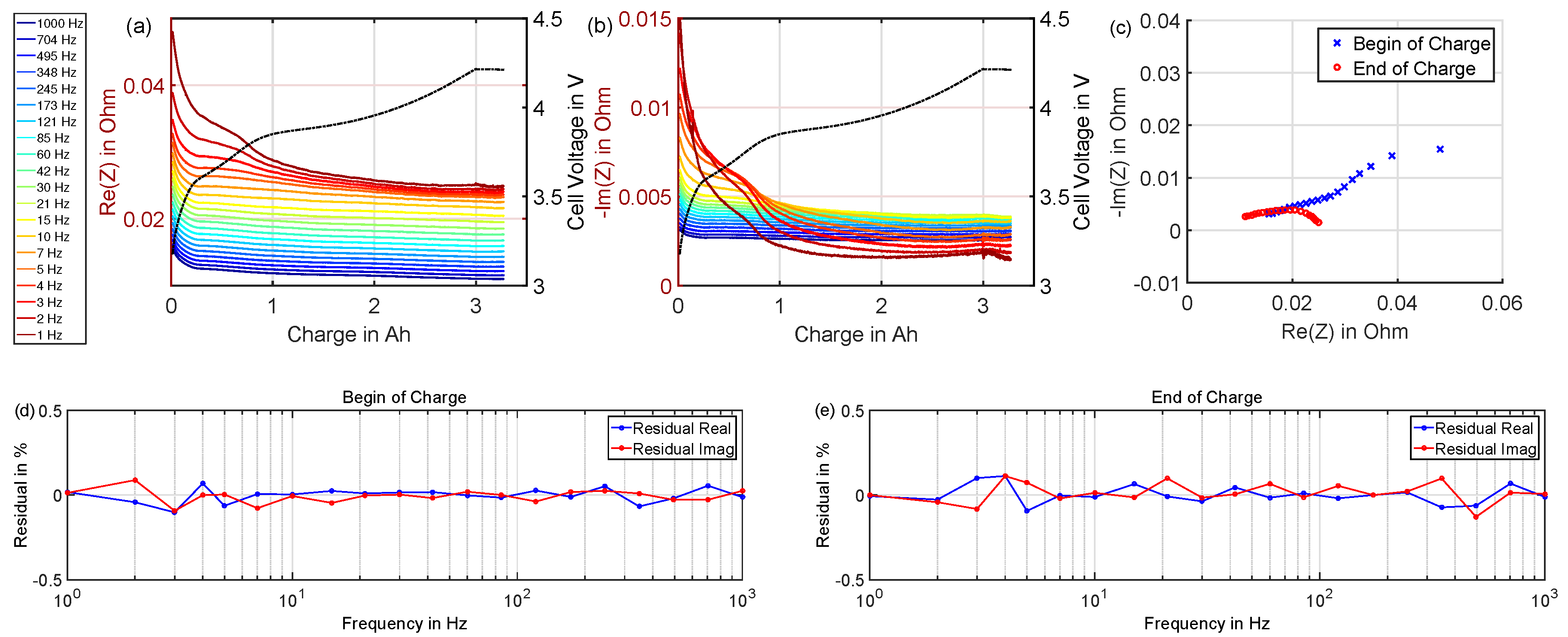
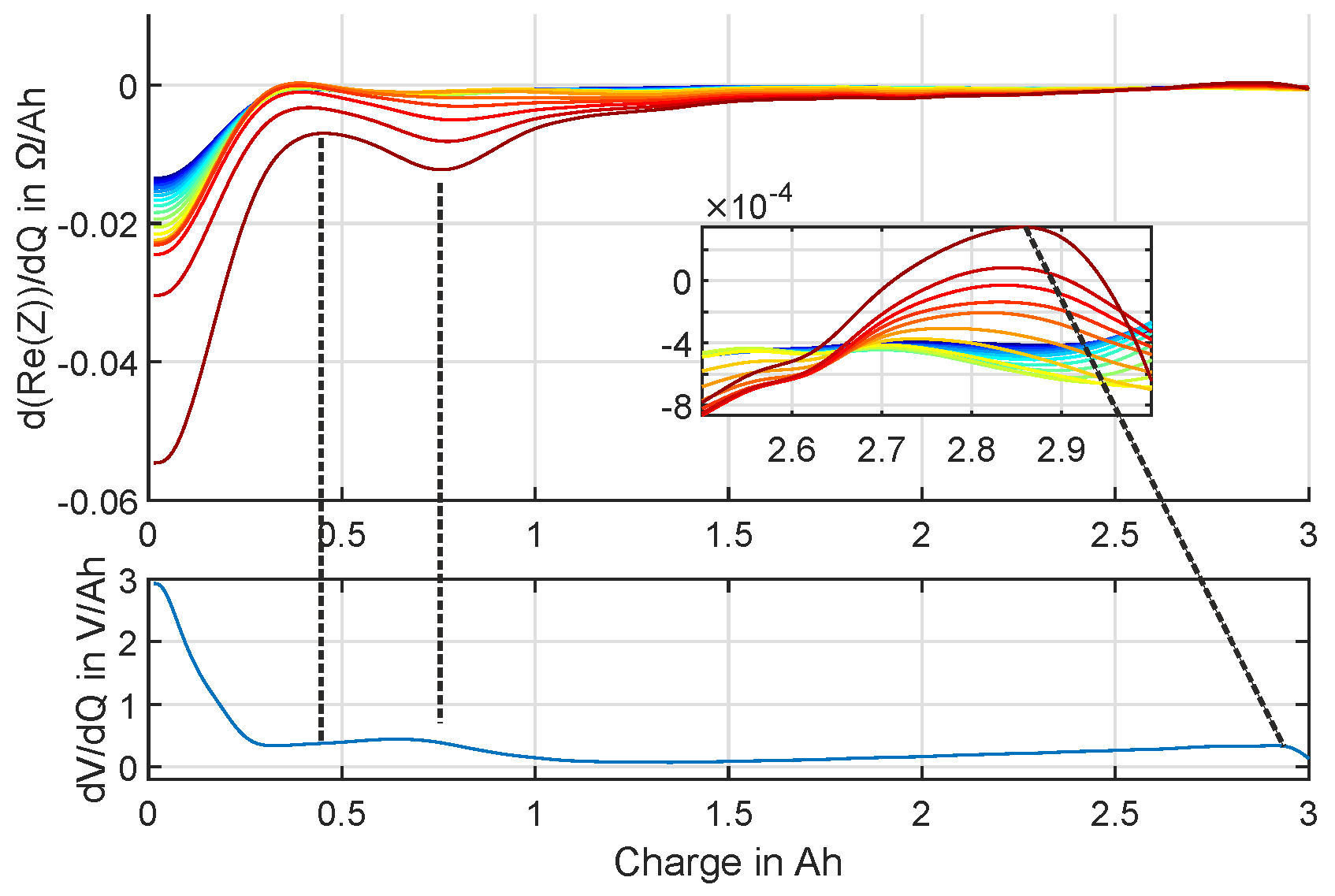
| Signal A | Signal B | Signal C | |
|---|---|---|---|
| 1 Hz | 1 Hz | 1 kHz | |
| 1 kHz | 1 kHz | 1 MHz | |
| Frequency distribution | quasi-logarithmic | linear | logarithmic |
| Number of frequency points | 21 | 21 | 21 |
| Number of samples | 96,000 | 96,000 | 96,000 |
| Length | 1 s | 1 s | 1 ms |
| Signal | Stepped-Sine | Multi-Sine |
|---|---|---|
| 1 Hz | 1 Hz | |
| 1 kHz | 1 kHz | |
| Frequency Distribution | quasi-logarithmic | |
| Frequency Points | 20 | 20 |
| Periods per Point | 10 | variable |
| RMS Current | mA | mA |
| Amplitude per Frequency Point | mA | mA |
| Peak Current Amplitude | mA | mA |
| Crest Factor | 1.41 | 2.528 |
| Signal Power | W | 561 W |
| Signal Length | s | 1 s |
| Signal Energy | mJ | mJ |
© 2018 by the authors. Licensee MDPI, Basel, Switzerland. This article is an open access article distributed under the terms and conditions of the Creative Commons Attribution (CC BY) license (http://creativecommons.org/licenses/by/4.0/).
Share and Cite
Zappen, H.; Ringbeck, F.; Sauer, D.U. Application of Time-Resolved Multi-Sine Impedance Spectroscopy for Lithium-Ion Battery Characterization. Batteries 2018, 4, 64. https://doi.org/10.3390/batteries4040064
Zappen H, Ringbeck F, Sauer DU. Application of Time-Resolved Multi-Sine Impedance Spectroscopy for Lithium-Ion Battery Characterization. Batteries. 2018; 4(4):64. https://doi.org/10.3390/batteries4040064
Chicago/Turabian StyleZappen, Hendrik, Florian Ringbeck, and Dirk Uwe Sauer. 2018. "Application of Time-Resolved Multi-Sine Impedance Spectroscopy for Lithium-Ion Battery Characterization" Batteries 4, no. 4: 64. https://doi.org/10.3390/batteries4040064
APA StyleZappen, H., Ringbeck, F., & Sauer, D. U. (2018). Application of Time-Resolved Multi-Sine Impedance Spectroscopy for Lithium-Ion Battery Characterization. Batteries, 4(4), 64. https://doi.org/10.3390/batteries4040064






